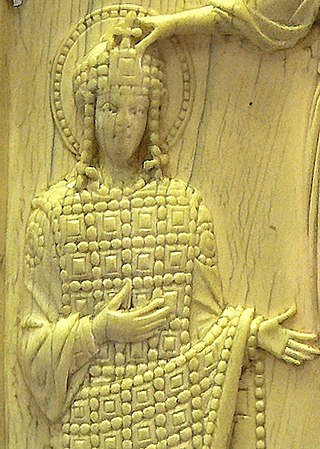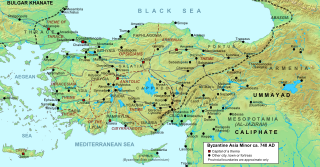
Nikephoros II Phokas, Latinized Nicephorus II Phocas, was Byzantine emperor from 963 to 969. His career, not uniformly successful in matters of statecraft or of war, nonetheless included brilliant military exploits which contributed to the resurgence of the Byzantine Empire during the 10th century. In the east, Nikephoros completed the conquest of Cilicia and retook the islands of Crete and Cyprus, opening the path for subsequent Byzantine incursions reaching as far as Upper Mesopotamia and the Levant; these campaigns earned him the sobriquet "pale death of the Saracens". Meanwhile in the west, he inflamed conflict with the Bulgarians and saw Sicily completely turn over to the Muslims, while he failed to make any serious gains in Italy following the incursions of Otto I. At home, Nikephoros' administrative policies caused controversy. He financed his wars with increased taxes both on the people and on the church, while maintaining unpopular theological positions and alienating many of his most powerful allies.These included his nephew John Tzimiskes, who would take the throne after killing Nikephoros in his sleep.

Romanos IIPorphyrogenitus was Byzantine Emperor from 959 to 963. He succeeded his father Constantine VII at the age of twenty-one and died suddenly and mysteriously four years later. His son Basil II the Bulgar slayer would ultimately succeed him in 976.

Constantine VII Porphyrogenitus was the fourth Emperor of the Macedonian dynasty of the Byzantine Empire, reigning from 6 June 913 to 9 November 959. He was the son of Emperor Leo VI and his fourth wife, Zoe Karbonopsina, and the nephew of his predecessor Alexander.
Leo Phokas was an early 10th-century Byzantine general of the noble Phokas clan. As Domestic of the Schools, the Byzantine army's commander-in-chief, he led a large-scale campaign against the Bulgarians in 917, but was heavily defeated at the battles of Acheloos and Katasyrtai. He then plotted to seize the throne from the young Byzantine emperor Constantine VII, but was outmaneuvered by the admiral Romanos Lekapenos, who managed to become guardian and later father-in-law of the Emperor. After Lekapenos seized control of the Byzantine Empire, Leo led an unsuccessful revolt, and was captured and blinded.
Bardas Phokas was a notable Byzantine general in the first half of the 10th century. He was the father of Byzantine emperor Nikephoros II Phokas and the kouropalates Leo Phokas the Younger.
The Excubitors were founded in c. 460 as an imperial guard unit by the Byzantine emperor Leo I the Thracian. The 300-strong force, originally recruited from among the warlike mountain tribe of the Isaurians, replaced the older Scholae Palatinae as the main imperial bodyguard. The Excubitors remained an active military unit for the next two centuries, although, as imperial bodyguards, they did not often go on campaign. Their commander, the count of the Excubitors, soon acquired great influence. Justin I was able to use this position to rise to the throne in 518, and henceforth the counts of the Excubitors were among the main political power-holders of their day; two more, Tiberius II Constantine and Maurice, rose to become emperors in the late 6th century.

The Byzantine Empire was ruled by the Isaurian or Syrian dynasty from 717 to 802. The Isaurian emperors were successful in defending and consolidating the Empire against the Caliphate after the onslaught of the early Muslim conquests, but were less successful in Europe, where they suffered setbacks against the Bulgars, had to give up the Exarchate of Ravenna, and lost influence over Italy and the Papacy to the growing power of the Franks.

The Byzantine Empire underwent a revival during the reign of the Macedonian emperors of the late 9th, 10th, and early 11th centuries, when it gained control over the Adriatic Sea, Southern Italy, and all of the territory of the Tsar Samuil of Bulgaria. The Macedonian dynasty was characterised by a cultural revival in spheres such as philosophy and the arts, and has been dubbed the "Golden Age" of Byzantium.

Between 780–1180, the Byzantine Empire and the Abbasid & Fatimid caliphates in the regions of Iraq, Palestine, Syria, Anatolia and Southern Italy fought a series of wars for supremacy in the Eastern Mediterranean. After a period of indecisive and slow border warfare, a string of almost unbroken Byzantine victories in the late 10th and early 11th centuries allowed three Byzantine Emperors, namely Nikephoros II Phokas, John I Tzimiskes and finally Basil II to recapture territory lost to the Muslim conquests in the 7th century Arab–Byzantine wars under the failing Heraclian Dynasty.

This article lists and briefly discusses the most important of many treatises on military science produced in the Byzantine Empire.
The Hikanatoi, sometimes Latinized as Hicanati, were one of the Byzantine tagmata, the elite guard units based near the imperial capital of Constantinople. Founded in the early 9th century, it survived until the late 11th century.

The Hetaireia was a term for a corps of bodyguards during the Byzantine Empire.
The menaulion or menavlion, also menaulon or menavlon (μέναυλον) was a heavy spear with a length of 2.7 to 3.6 metres with a thick shaft, used by the Byzantine infantry as early as the 10th century AD, against enemy heavy cavalry. To give it increased strength, whole oak or cornel saplings were preferably used. These were then tipped with a long blade of ca. 45–50 cm.

The Anatolic Theme, more properly known as the Theme of the Anatolics, was a Byzantine theme in central Asia Minor. From its establishment, it was the largest and senior-most of the themes, and its military governors (stratēgoi) were powerful individuals, several of them rising to the imperial throne or launching failed rebellions to capture it. The theme and its army played an important role in the Arab–Byzantine wars of the 7th–10th centuries, after which it enjoyed a period of relative peace that lasted until its conquest by the Seljuk Turks in the late 1070s.
Aplekton was a Byzantine term used in the 10th–14th centuries for a fortified army base and later in the Palaiologan period for the obligation of billeting soldiers.

Sviatoslav's invasion of Bulgaria refers to a conflict beginning in 967/968 and ending in 971, carried out in the eastern Balkans, and involving the Kievan Rus', Bulgaria, and the Byzantine Empire. The Byzantines encouraged the Rus' ruler Sviatoslav to attack Bulgaria, leading to the defeat of the Bulgarian forces and the occupation of the northern and north-eastern part of the country by the Rus' for the following two years. The allies then turned against each other, and the ensuing military confrontation ended with a Byzantine victory. The Rus' withdrew and eastern Bulgaria was incorporated into the Byzantine Empire.
Phokas or Phocas (Latinized), feminine form Phokaina or Phocaena, was the name of a Byzantine aristocratic clan from Cappadocia, which in the 9th and 10th centuries provided a series of high-ranking generals and an emperor, Nikephoros II Phokas. Its members and their clients monopolized the high-command positions of the Byzantine army for much of the 10th century and led the successful Byzantine offensive against the Arabs in the East. As one of the leading families of the Anatolian military aristocracy, the Phokades were also involved in a series of rebellions that laid claim to power and challenged the emperors at Constantinople. Their power was eventually broken by Basil II, and the family declined in importance after the 11th century.

Byzantine Anatolia refers to the peninsula of Anatolia during the rule of the Byzantine Empire. Anatolia was of vital importance to the empire following the Islamic invasion of the Levant and Egypt during the reign of the Byzantine Emperor Heraclius in the years 634–645. Over the next two hundred and fifty years, the region suffered constant raids by Arab Muslim forces raiding mainly from the cities of Antioch, Tarsus, and Aleppo near the Anatolian borders. However, the Byzantine Empire maintained control over the Anatolian peninsula until the High Middle Ages, when imperial authority in the area began to collapse.

The Byzantine Empire was ruled by emperors of the Doukas dynasty between 1059 and 1081. There are six emperors and co-emperors of this period: the dynasty's founder, Emperor Constantine X Doukas, his brother John Doukas, katepano and later Caesar, Romanos IV Diogenes, Constantine's son Michael VII Doukas, Michael's son and co-emperor Constantine Doukas, and finally Nikephoros III Botaneiates, who claimed descent from the Phokas family.










